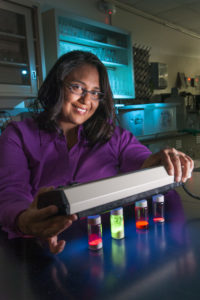By Sandia National Laboratories Staff
The technical achievements of a Colorado State University alumna and Sandia National Laboratories innovator were recognized with a 2016 Hispanic Engineer National Achievement Awards Conference (HENAAC) Award. The award was from Great Minds in STEM, an organization supporting careers in science, technology, engineering, and math.

Chemist Bernadette “Bernie” Hernandez-Sanchez, (Ph.D. ’04), won for outstanding technical achievement and is the first woman at Sandia to receive this award. She grew up in an impoverished area of Albuquerque, attended an underserved public high school, started at Sandia as a high school intern, and was the first in her family to go to college.
Hernandez-Sanchez and a Sandia colleague were recognized at the 28th Annual HENAAC Conference in Anaheim, California, during National Hispanic Heritage Month.
HENAAC honors Hispanic researchers who have made significant contributions to the nation’s technical community. Awardees are peer-reviewed and come from a wide range of private industry, academia, military, and government organizations.
Advanced materials
“The first time I ever met a scientist was when I started my internship at Sandia,” said Hernandez-Sanchez, who is from Albuquerque’s south valley, where few people she knew went to college.
Today, she’s an accomplished chemist. Hernandez-Sanchez’s technical achievements focus on the morphology, structure, and properties of nanomaterials for real-world applications that range from renewable energy to homeland security.
As the principal investigator for Sandia’s Marine Hydrokinetic Advanced Materials program, she has made important contributions to studies of corrosion and other materials challenges for underwater devices that aim to harness clean energy for electricity. In one project, she is developing nano-engineered copper-silver coatings to keep microorganisms from growing on underwater equipment. She said the coatings come from techniques she has spent more than 10 years developing in Sandia’s Advanced Materials Laboratory (AML).
Through the New Mexico Small Business Assistance program, Hernandez-Sanchez is helping a Santa Fe company, bioLime, improve the chemistry of stucco, a staple material in Southwestern homes that is prone to cracking as it ages.
In addition, she has contributed to Sandia’s NanoCRISPR genetics project, Laboratory Directed Research and Development (LDRD) program, and to improving the chemistry of lithium-ion batteries and ferroelectric perovskite materials.
Intern to mentor
Hernandez-Sanchez holds a doctorate in inorganic solid state chemistry from Colorado State University, where she was co-advised by Professors Ellen Fisher and Peter Dorhout. She has a bachelor’s in chemistry from New Mexico Institute of Mining and Technology in Socorro, and she has published 28 technical papers and has been awarded two patents.
Alongside her technical work, Hernandez-Sanchez has mentored more than 50 interns in her lab, many of whom have gone on to pursue graduate degrees in chemistry. Sonia Mendoza, a chemistry student from Universidad del Valle de Mexico said, “Working with Bernie, I learned to challenge myself and that anything is possible, no matter your background. Bernie taught me to not always trust published work, but to prove things yourself through science.”
In addition to mentoring undergrads, Hernandez-Sanchez works with underrepresented elementary and middle school students to get them excited about science.
“I like to give back, because I look at them and see myself. I understand the importance of being introduced to new concepts and role models in order to encourage student interest,” she said.
Hernandez-Sanchez is the co-creator of CSI: Dognapping – a lively, interactive workshop that shows kids the fun in science. The program has reached 5,000 local students and was honored by the American Chemical Society with the 2015 ChemLuminary Award for Outstanding Kids & Chemistry.